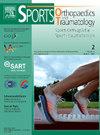Entwicklung von Meniskusimplantaten mithilfe virtueller Simulationsmethoden: Eine interdisziplinäre Herangehensweise
Q4 Health Professions
引用次数: 0
Abstract
Der Meniskus ist ein integraler Bestandteil eines gesunden Kniegelenks. Er besteht hauptsächlich aus Kollagenfasern, die dreischichtig angeordnet sind. Insbesondere die tiefe, zirkumferente Kollagenfaserschicht ermöglicht die Umwandlung axialer Druckbelastung in zirkumferenten Stress, was zur Lastenverteilung auf dem Tibiaplateau und zum Schutz des Knorpels beiträgt. Meniskusverletzungen sind häufig und erhöhen das Risiko einer Osteoarthrose erheblich. Bei akuten traumatischen sowie degenerativ bedingten Meniskusverletzungen wird zunächst eine konservative Therapie empfohlen, sofern keine mechanischen Symptome wie Gelenkblockaden vorliegen. Diese umfasst unter anderem Physiotherapie, entzündungshemmende Medikamente und intraartikuläre Injektionen. Bei persistierenden Beschwerden oder mechanischen Einschränkungen kann jedoch eine arthroskopische Intervention erforderlich sein. Neben der Meniskusnaht und der partiellen Meniskektomie stellen allogene Meniskustransplantationen sowie der Einsatz von Meniskusimplantaten vielversprechende therapeutische Alternativen dar, insbesondere bei ausgedehnten Meniskusschäden. Kommerziell erhältliche Meniskusimplantate scheitern unteranderem jedoch oft daran, die natürliche Kollagenfaserorientierung nachzuahmen. Die Finite-Elemente-Methode (FEM) bietet eine virtuelle Simulationsplattform, um Implantate effizienter zu entwickeln und zu testen. Eine interdisziplinäre Zusammenarbeit ist dabei unerlässlich.
The meniscus is an integral part of a healthy knee joint. It consists mainly of collagen fibers, which are arranged in a three-layered manner. In particular, the deep, circumferential collagen fiber layer enables the conversion of axial compressive loads into circumferential hoop stress, contributing to load distribution on the tibial plateau and protecting the cartilage. Meniscus injuries are common and significantly increase the risk of osteoarthritis. In cases of acute traumatic or degenerative meniscus injuries, conservative therapy is initially recommended, provided there are no mechanical symptoms such as joint locking. This therapy includes physiotherapy, anti-inflammatory medications, and intra-articular injections. However, if symptoms persist or mechanical restrictions occur, arthroscopic intervention may be necessary. In addition to meniscus suturing and partial meniscectomy, allogeneic meniscus transplantation and the use of meniscus implants represent promising therapeutic alternatives, particularly for extensive meniscus damage. However, commercially available meniscus implants often fail to replicate the natural collagen fiber orientation. The finite element method (FEM) provides a virtual simulation platform to develop and test implants more efficiently. Interdisciplinary collaboration is essential in this process.
使用虚拟模拟方法开发半月板植入物:跨学科方法
半月板是膝关节健康的重要组成部分。它主要由三层排列的胶原纤维组成。特别是,深的环外胶原纤维层使轴向压力转化为环外应力成为可能,这有助于胫骨高原的负荷分布和软骨的保护。半月板损伤是常见的,并显著增加骨关节炎的风险。在急性创伤性和退行性半月板损伤的情况下,如果没有关节阻塞等机械症状,建议使用保守治疗。这包括物理治疗、抗炎药物和关节内注射。然而,在持续疼痛或机械限制的情况下,关节镜干预可能是必要的。除了半月板缝合和部分半月板切除术,同种异体半月板移植和植入物的使用是有希望的治疗选择,特别是在半月板广泛损伤的情况下。然而,商业上可用的半月板植入物往往不能模仿胶原纤维的自然定位。有限元方法(FEM)提供了一个虚拟模拟平台,以更有效地开发和测试植入物。在这方面,跨学科合作至关重要。半月板是膝关节健康的重要组成部分。它主要由胶原纤维组成,以三层的方式排列。特别是,深的、周周的胶原纤维层能够将轴向压缩载荷转化为周周箍应力,有助于胫骨高原上的载荷分布,保护软骨。半月板损伤是常见的,并显著增加骨关节炎的风险。在急性创伤或退行性半月板损伤的情况下,最初建议保守治疗,前提是没有机械症状,如关节闭锁。这种治疗包括物理治疗、抗炎药物和关节内注射。然而,如果症状持续或机械限制发生,关节镜干预可能是必要的。半月板移植和半月板植入是一种有希望的治疗选择,特别是在广泛的半月板损伤。然而,商业上可用的半月板植入物往往无法复制天然胶原纤维取向。有限元法(FEM)为更有效地开发和测试植入物提供了一个虚拟模拟平台。在这个过程中,跨学科合作是必不可少的。
本文章由计算机程序翻译,如有差异,请以英文原文为准。
求助全文
约1分钟内获得全文
求助全文
来源期刊

Sports Orthopaedics and Traumatology
Health Professions-Physical Therapy, Sports Therapy and Rehabilitation
CiteScore
0.70
自引率
0.00%
发文量
145
审稿时长
43 days
 求助内容:
求助内容: 应助结果提醒方式:
应助结果提醒方式:


